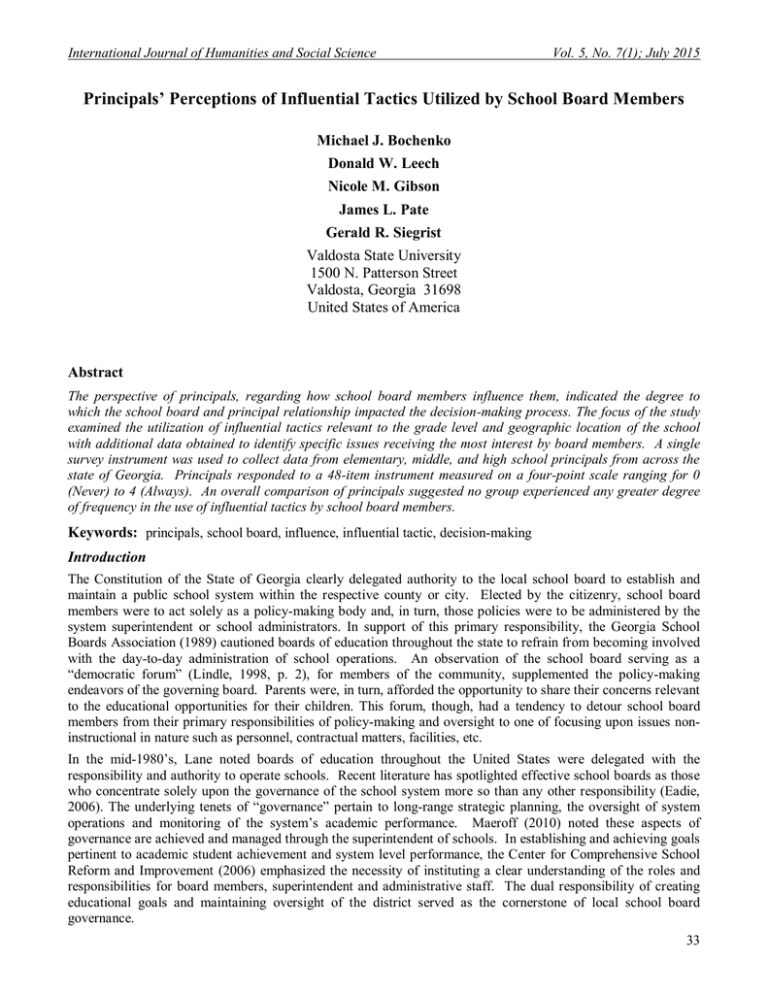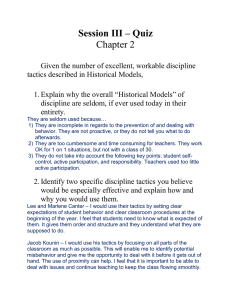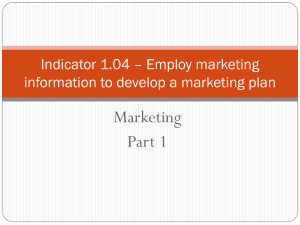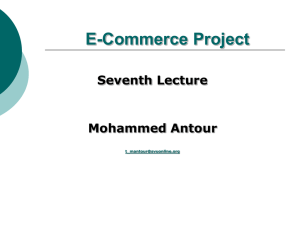Principals’ Perceptions of Influential Tactics Utilized by School Board Members
advertisement

International Journal of Humanities and Social Science Vol. 5, No. 7(1); July 2015 Principals’ Perceptions of Influential Tactics Utilized by School Board Members Michael J. Bochenko Donald W. Leech Nicole M. Gibson James L. Pate Gerald R. Siegrist Valdosta State University 1500 N. Patterson Street Valdosta, Georgia 31698 United States of America Abstract The perspective of principals, regarding how school board members influence them, indicated the degree to which the school board and principal relationship impacted the decision-making process. The focus of the study examined the utilization of influential tactics relevant to the grade level and geographic location of the school with additional data obtained to identify specific issues receiving the most interest by board members. A single survey instrument was used to collect data from elementary, middle, and high school principals from across the state of Georgia. Principals responded to a 48-item instrument measured on a four-point scale ranging for 0 (Never) to 4 (Always). An overall comparison of principals suggested no group experienced any greater degree of frequency in the use of influential tactics by school board members. Keywords: principals, school board, influence, influential tactic, decision-making Introduction The Constitution of the State of Georgia clearly delegated authority to the local school board to establish and maintain a public school system within the respective county or city. Elected by the citizenry, school board members were to act solely as a policy-making body and, in turn, those policies were to be administered by the system superintendent or school administrators. In support of this primary responsibility, the Georgia School Boards Association (1989) cautioned boards of education throughout the state to refrain from becoming involved with the day-to-day administration of school operations. An observation of the school board serving as a “democratic forum” (Lindle, 1998, p. 2), for members of the community, supplemented the policy-making endeavors of the governing board. Parents were, in turn, afforded the opportunity to share their concerns relevant to the educational opportunities for their children. This forum, though, had a tendency to detour school board members from their primary responsibilities of policy-making and oversight to one of focusing upon issues noninstructional in nature such as personnel, contractual matters, facilities, etc. In the mid-1980’s, Lane noted boards of education throughout the United States were delegated with the responsibility and authority to operate schools. Recent literature has spotlighted effective school boards as those who concentrate solely upon the governance of the school system more so than any other responsibility (Eadie, 2006). The underlying tenets of “governance” pertain to long-range strategic planning, the oversight of system operations and monitoring of the system’s academic performance. Maeroff (2010) noted these aspects of governance are achieved and managed through the superintendent of schools. In establishing and achieving goals pertinent to academic student achievement and system level performance, the Center for Comprehensive School Reform and Improvement (2006) emphasized the necessity of instituting a clear understanding of the roles and responsibilities for board members, superintendent and administrative staff. The dual responsibility of creating educational goals and maintaining oversight of the district served as the cornerstone of local school board governance. 33 ISSN 2220-8488 (Print), 2221-0989 (Online) ©Center for Promoting Ideas, USA www.ijhssnet.com The past several decades, school boards have strayed from the primary responsibility of governance and oversight (Cusik & Peters, 1978; Bolman & Deal, 1992; & Grillo, 2009). Recent events arising in the state of Georgia have resulted in school boards becoming subject to journalistic investigations. The behavior of school boards led to actions disrupting the operation of individual schools or departments within the system’s administrative offices (Badertscher & Salzer, 2010). In one such school system, the severity of interference lent itself to the loss of national accreditation. Such conduct permeated across several school districts of varying size and scope. In each case, board members exhibited a tendency to behave in a manner well outside the scope of their defined responsibilities. Influence has been identified as an indicator of power within a relationship. A historic study by French and Raven (1959) identified the concept of power being attained by one elected to a position of authority such as the school board member. Many years later, and supported by a number of authors, Lines (2007) noted a distinct relationship, or link, between power and the use of influential strategies. The purpose of this study was to determine the perceptions of school principals regarding tactics utilized by school board members to influence their (principals) administrative decision-making process. The concept of influence directly impacts upon the culture and direction of each school (Owens & Valesky, 2007). Interactions encountered between school board members and principals at various levels, locations, or points in time lend itself to the employment of multifaceted influential tactics (Ogawa & Bossert, 2000). School principals must be vigilant in recognizing, and adapting to, such influencing measures. Overview Principals throughout the state of Georgia were invited to respond to a single instrument, the School Board Behavior Survey adopted from Yukl’s Influence Behavior Questionnaire, comprised of 48 items using a 4-point ordered response (Yukl, Seifert & Chavez, 2008). The collected data, categorized across three grade levels (elementary, middle and high school) and geographic locations (rural, micropolitan and metropolitan), measured the principal’s perception of the frequency of influential tactics used by school board members. In addition to the influential tactics, principals identified the degree four specific issues (personnel, discipline, budget and facilities), relevant to the overall operation of the school, were addressed by members of the local school board. Geographic locations were identified through definitions obtained from the United States Office of Management and Budget (2013). A metropolitan contained a core urban area of 50,000 or more population, whereas an area containing an urban core of at least 10,000, but less than 50,000, population would be considered as micropolitan. All counties not part of a Metropolitan Statistical Area (MSA) were considered rural and having a population of 9,999 or less. The survey was disseminated to 1365 principals representing 147 school districts across the state. Approximately 19% of the targeted population initiated the survey with 201 principals, or 15%, serving as a sample for the purposes of this research. Respondents were evenly represented in terms of gender with slightly more male (51%) than female (49%) respondents. Experience as a principal identified 5% of the respondents with 16-20 years in their position whereas 48% the principals indicated a range of 0-5 years. A somewhat significant difference appeared in the number of participating principals identified by grade level. Elementary principals (50%) were highly represented in comparison to middle (21%) and high school (29%) principals. The total number of respondents representing each grade level was proportional to the total number of schools throughout the state. According to the Georgia Department of Education (2013), 58% of all schools were elementary, 22% were middle schools and 20% were high schools. Demographics related to the geographic location of the school found rural school principals (57%) were represented significantly more often than micropolitan (24%) and metropolitan school (19%) principals. The study, using a causal-comparative research design, employed scale score data provided through the survey instrument. The data indicated the degree each influential tactic was utilized by school board members. The eleven influential tactics (Table 1) were measured individually and in total. Forty-four questions, with 4 questions per tactic, were specifically associated to the tactics. Four additional questions measured the degree of frequency for each issue presented in the survey. Quantitative data were calculated for significant differences between the two groups of principals designated by grade level and geographic location. Total scale scores pertaining to all influential tactics were evaluated using a one-way analysis of variance (ANOVA) providing a comparison between each of the principal categories. Descriptive statistics were assessed to identify specific influential tactics principals noted as being utilized most frequently. Scale scores assisted in determining the emergence of those issues predominantly addressed by school board members as identified by the principals. 34 International Journal of Humanities and Social Science Vol. 5, No. 7(1); July 2015 Summary of Findings One purpose of the research was to determine if a statistically significant difference in the use of influential tactics existed based upon the geographic location of the respective school. The one-way ANOVA analysis, computed for the three geographic locations of all influential tactics combined, reported there was not a statistically significant difference in tactics (p>.05, p = .74). Descriptive statistics measured a lower degree of frequency for all influential tactics combined. In assessing each geographical location, aggregated scale scores of principals in rural school districts reported the highest degree of frequency (33.4%) of school board members utilizing all influential tactics combined. Metropolitan (30.7%) and micropolitan (28.2%) school principals followed in succession. Tests conducted to determine the mean and standard deviation for each of the variables produced indicators supporting the scale scores rating a higher degree of frequency within rural school districts, followed closely by metropolitan and micropolitan geographical locations. In assessing the descriptive statistics, principals reported a mid-level degree of frequency in the use of each individual influential tactic ranging from approximately 28% to 33%. Micropolitan (50%) and metropolitan (47.4%) school principals noted rational persuasion having the greatest degree of frequency, whereas rural (48.9%) school principals indicated consultation being applied most frequently. The means and standard deviations for each sample found significant differences for three of the 11 tactics. Rational persuasion, consultation and inspirational were significantly related to all three geographic locations of schools. Yukl (2002) identified consultation and rational persuasion within the four core influential tactics with collaboration and inspirational completing the group. These core tactics came about after several studies revealed the tactics were most likely to prompt a commitment by the target. Utilization of the consultation and rational persuasion tactics, as identified by the three groups of principals, concurred with the findings of Yukl and Michel (2006). A greater use of core tactics between an agent-target (i.e., board member-principal) relationship was formed on the basis of personal compatibility, competence, and dependability exhibited by the target (Graen & Cashman, 1975). Such a relationship creates mutual trust and a grasp of shared objectives (Yukl & Michel, 2006) resulting in consultation and rational persuasion to be effective. A stark contrast to these results found the exchange influence tactic having the lowest frequency reported by the three principal groups. The exchange tactic relies upon one offering a reward for the completion of a requested task or objective. The elements of trust and shared goals, understood in using the more effective tactics of consultation and rational persuasion, trump the need for any reward other than what is appropriate for the effort put forth by the principal. A second objective of the research attempted to assess the same 11 influential tactics utilized by school board members in determining if a statistically significant difference existed based upon the grade level of the respective school (elementary, middle and high school). The one-way ANOVA analysis computed for the three grade levels of all influential tactics combined reported there was a modest statistically significant difference in tactics (p< .05, p = .01). Aggregated scale scores measured a wide range in the utilization of all influential tactics combined. Principals at the high school level reported the highest degree of frequency (39.6%) for all influential tactics combined followed closely by middle school principals (36.5%). Elementary school principals reported a much lower degree of tactics (23.5%) being used as compared to the other two grade levels. The mean and standard deviation for each of the variables produced indicators supporting the scale scores for all three grade levels. Descriptive statistics were used to identify the individual influential tactics utilized most frequently by school board members. In comparison to the statistics derived from the varying geographic locations of schools, principals within each grade level reported a higher level of frequency of tactics being used. Middle school principals reported the highest degree of frequency (60.4%) regarding the tactic of rational persuasion, closely followed by high school principals noting a high incidence (59.1%) of the consultation tactic. Elementary principals (40.9%) acknowledged consultation as the predominant tactic. The means and standard deviations for each sample found significant differences for four of the 11 tactics. Rational persuasion, consultation and inspirational tactics were significantly related to each of the three grade locations of schools. In addition to these three tactics, the legitimating tactic was reported within the same mean and standard deviation. Yukl and Michel (2006) explained the legitimating tactic demonstrates a request is legitimate and the agent (school board member) has the authority to make such a request. They further allude to the concept of the agent, or leader, being more trusted to make only legitimate requests. Responding principals at the elementary (31.6%), middle (45.7%), and high (47.8%) school level have experienced a higher degree of trust between themselves and the school board members, thus identifying legitimating as one of the more significant tactics. 35 ISSN 2220-8488 (Print), 2221-0989 (Online) ©Center for Promoting Ideas, USA www.ijhssnet.com The final research component attempted to ascertain the issues most often focused upon by school board members. The four issues presented to the principals dealt with personnel, budget, discipline and facilities. Descriptive statistics were obtained from principals at both the geographical location and grade level. Principals in rural schools reported a high degree of frequency with those issues relevant to facilities and personnel. Metropolitan and micropolitan principals indicated a similarly high degree of frequency in respect to facility issues (Table 2). These findings run contrary to the leading concerns of school board members identified by Hess and Leal (2003). Of similar issues presented in the this research (personnel, budget, discipline and facilities), Hess and Leal noted budgetary issues as the leading concern among school board members of similar sized districts. Disciplinary issues exhibited a very low degree of frequency for principals across all three geographical locations. Although it was not rated as the least of the concerns, Hess and Leal (2003) noted discipline ranking toward the bottom of their study. The mean and standard deviations for each of the variables reinforced the findings within the degree of frequency. The rural and micropolitan school principals exhibited an extremely high mean score in relation to personnel and facility issues. Metropolitan principal scores fell within the mid-range for both budget and facility. Similar descriptive statistics to those obtained at the geographic location emerged within the grade level sample (Table 3). High school principals reported a high degree of frequency for issues pertaining to personnel. Middle and elementary school principals conveyed issues regarding facilities being the most prominent. Elementary and middle school principals identified discipline being the least addressed of all four issues. Budgetary issues were reported at the lowest frequency for high school principals. Mean and standard deviation totals mirrored the descriptive statistics measured for the three grade levels Discussion This research study was designed to measure the perceptions of principals as to how school board members utilized various tactics to influence the administrative decision-making process. Two components of the research examined whether or not there was a significant difference observed in the number of tactics used based upon the geographic location or grade level of the school. Yukl and Michel (2006) were able to identify four studies regarding the use of influential tactics between leaders and subordinates and how a relationship is formed between the two parties. No studies were found to investigate how these proactive influential tactics were applied in an academic setting. The study drew comparisons of utilized tactics between principals employed in rural, micropolitan and metropolitan school as well as those situated in elementary, middle and high schools. Within the grade level sample group, results suggested influential tactics have a significant effect among the three different groups of principals when comparing their perceptions from one to another. With a p-value of .01, one might reasonably subscribe to the idea of influential tactics used by school board members as observed by elementary, middle, and high school principals. On the other hand, the data proposes no significance in the utilization of influential tactics as perceived by rural, micropolitan, or metropolitan principals. A p-value of .74readily discounts the utilization of influential tactics by board members associated with rural, micropolitan, or metropolitan school principals. A distribution of aggregated scale scores illustrated a mid- to high degree of frequency for the individual influential tactics utilized at varying geographic locations from 28.1% through 33.4% and grade levels at 23.6% to 39.6%. Of the 11 identified influential tactics, seven(apprising, collaboration, coalition, exchange, ingratiation, pressure, personal) were noted to have little, if any, significance between principals and school board members. Observations by Yukl, Falbe and Youn (1993) suggested these seven particular tactics were used in order to achieve a specific objective or when predicated by role expectations. Their findings concurred with an earlier conclusion identifying three variables affecting the choice of influence strategies. Those variables were: 1) relative power; 2) the objective to be attained by using influence; and, 3) expectation of compliance by the individual being influenced (Kipnis, Schmidt, Swaffin-Smith & Wilkinson, 1984). The seven tactics exhibiting minimal significance within this study have been designated as “harsh” or “hard” tactics by van Knippenberg, van Eijbergen & Wilke (1999). Harsh or hard tactics have a tendency to be more controlling or coercive, whereas, contrarily, a “soft” tactic allows an individual the freedom to choose to comply (van Knippenberg, van Eijbergen & Wilke, 1999). School board members avoid utilizing harsh tactics in order to avoid the impression of restricting a principal’s autonomy or appearing unjust (Klocke, 2009). The primary finding of a study conducted by van Knippenberg and Steensma (2003) concluded hard tactics are used less often than soft tactics. 36 International Journal of Humanities and Social Science Vol. 5, No. 7(1); July 2015 Their conclusion highlighted the potential strain placed upon a relationship between the agent and the target would lead an individual to use soft tactics more frequently. van Knippenberg and Steensma (2003) further observed the opportunity for future interactions among individuals played a key role in avoiding the utilization of any influential tactics, but even more so in the employment of hard tactics. Although hard tactics may bring about one’s compliance, it can result in resistance by the target (Falbe & Yukl, 1990; Yukl & Tracy, 1992). Principals may perceive hard tactics used by school board members as coercive or controlling in nature. Whereas these tactics are considered less friendly or socially unacceptable, they serve as a distinct contrast to soft tactics providing the target with a greater freedom of choice (van Knippenberg, B., van Eijbergen, R., & Wilke, H., 1999; Raven, B. H., 1992; & Yukl, G., & Tracy, 1992). In comparing scale scores between the two categories of geographic location and grade level, there were significant similarities in the principals’ perceptions pertaining to the use of two specific tactics: rational persuasion and consultation. Both tactics used in some combination when attempting to influence subordinates or peers (Yukl, Falbe & Youn, 1993). Mehta and Krishnan (2004) noted how managers utilize any combination of tactics to obtain a desired outcome, but their study of transformational leadership concluded a greater application of soft tactics. The concept of transformational leadership may explain the greater use of soft tactics by school board members. A recent trend in applying transformational leadership to achieve positive educational outcomes has been observed (Thompson, Templeton, & Ballenger, 2013). Fullan (2007) observed the key to transformation is the engagement of stakeholders. As implied earlier, soft tactics avoid any perceived strain in a relationship and, thus, may contribute to the engagement of all stakeholders; in this case, school board members and principals. Recommendations for Further Research Additional research is recommended to better understand influential tactics experienced in the school board member-principal relationship and identify outlying variables impacting upon the utilization of such tactics. More specifically, research into the gender make-up of a school board may provide insight as to why such tactics are, or are not, implemented. Soft tactics such as rational persuasion, inspirational, and consultation surfaced with a greater degree of frequency in this research and are often attributed to females in a position of authority (Yukl, et.al). Expanded research in this area would add to the reliability of the study in correlating the frequency of identified tactics to a specific gender of school board members. In the current study, the comparison of principal perceptions represented a wide, somewhat generic sample of groups by grade level and/or geographic location. It would be of interest to compare the understandings of principals refined through gender or individual years of experience as a principal. Administrators at the infancy of their career may have greater exposure to school board influence due or they may be naïve in recognizing any attempt to influence their decisions. Whereas, a more seasoned principal may have acquired the knowledge to distinguish influential tendencies and developed strategies to divert or isolate such tactics. Finally, further research may examine more closely the links between influential tactics and leadership styles of school board members. An instrument such as the Leader Behavior Description Questionnaire (LBDQ), developed at Ohio State University, provides principals the opportunity to describe the behavior of school board members as leaders within the school district. Blake and Mouton, who noted “the process of achieving organization purpose through the efforts of several people results in responsibility (power) for planning, controlling, and directing the activities of others through a hierarchical arrangement” (1978, p. 8) developed the Managerial Grid to measure two behavior dimensions. The first measures the degree of one’s concern for people, the other focuses upon one’s concern for production. Although these are just two instruments designed to gauge leadership styles, additional information gained from such resources might aid in establishing greater accuracy in how influential tactics are observed, or perceived to be utilized, by school principals. Final Thoughts and Conclusion The primary implication of the study’s findings is a perception by school principals of the minimal use of influential tactics by school board members. It is significant to note principals, identified by either geographic location or school grade level, made similar observations. As important, the practical implication is the limited contact or interaction between principals and members of the local school board. Local school superintendents who successfully serve as a “buffer” between board members and principals may buttress this limited interaction. Another implication is the autonomy given each principal to manage the educational, fiscal, and human resource components of their respective school. 37 ISSN 2220-8488 (Print), 2221-0989 (Online) ©Center for Promoting Ideas, USA www.ijhssnet.com School board members, represented by the available data, may adhere to the primary role of governing the school district through policy formation and oversight and relinquishing site-based management of schools to the respective principal. Embracing this role may be enhanced by their participation in exemplary leadership training sessions placing greater emphasis upon the professional and ethical responsibilities attributed to being a responsible school board member. Finally, principals of rural school districts might anticipate a higher tendency of school board members to use influential tactics. This greater affinity to influence may be attributed to the fact that smaller communities have a higher degree of “ownership” of their schools. This same, smaller community provides a greater ease of accessibility to school administrators through interaction initiated outside the confines of the school environment. Religious affiliations, membership in civic or professional organizations, and supporting locally owned businesses by school board members are just a representative sample of locations prime for one-on-one conversations. The kinship of individuals in rural communities extends to having family members and close, personal friends working in the school system. Having such a connection to the school district lends itself to a greater likelihood of these individuals impacted by personnel issues. This is compounded by the readily, and easily, available avenues of communication between school personnel, albeit professional, friend, or family ties, and board members. Consequently, board members may have a greater tendency to intervene on behalf of these individuals and the respective school principal. Information compiled from the data can aid principals in becoming more cognizant of such influential tactics. In the event board members increasingly utilize such tactics, the need to create interventions or establish strategies aimed at assisting the principal in managing such tactics could prove beneficial. Such efforts by school board members to influence principal’s decisions should be readily communicated to the superintendent. Furthermore, the school principal must work to acquire the necessary skills to proactively identify and address those issues brought to the forefront through the use of influential tactics by the board member. With a greater cognizance of such issues and tactics, principals can maintain a positive, professional rapport with board members. References Badertscher, N. & Salzer, J. (2010, October 10). School boards: who they are, why some don’t measure up. The Atlanta Journal-Constitution. Blake, R. R., & Mouton, J. S. (1978). The New Managerial Grid. Houston, TX: Gulf Publishing Company. Bolman, L. G., & Deal, T. E. (1992).Images of leadership. American School Board Journal, 179(4), 36-39. Center or Comprehensive School Reform (2006). Defining the role of school boards: architect, communicator, leader. Learning Point Associates Newsletter. Washington, D.C. Cusik, P. A., & Peters, W. L. (1978, March). The role of the secondary principal in small towns. Paper presented at the annual meeting of the American Educational Research Association, Toronto, Canada. Eadie, D. (2006). Five Habits of High-Impact School Boards. Lanham, MD: Rowman and Littlefield Publishers, Inc. Falbe, C. M. & Yukl, G. (1992). Consequences for managers of using single influence tactics and combination of tactics. Academy of Management Journal, 35, 638-651 French, J. R. P., Jr., & Raven, B. H. (1959). The bases of social power. In D. Cartwright (Ed.), Studies in Social Power (pp. 150–167). Ann Arbor, MI: Institute for Social Research. Fullan, M. (2007). The New Meaning of Educational Change. New York, NY: Teacher College Press. Georgia Department of Education (2013). Quick facts about Georgia public education. Retrieved from http://www.gadoe.org/External-Affairs-and Policy/communications/Documents/Quick%20Facts%20About%20Georgia%20Public%20K12%20Education%202013.pdf Georgia School Boards Association, Inc. (1989). Handbook: School Board Members Must Know (12th ed.). Lawrenceville, GA. Graen, G. & Chasman, J. (1975). A role-making model of leadership in formal organizations: A development approach. In J. G. Hunt & L. L. Larson (Eds.), Leadership Frontiers (pp. 143-165). Kent, OH: Kent State University. Grillo, J. (2009, June). Holding School Boards Accountable. Georgia Trend. Retrieved from http://www.georgiatrend.com/June-2009/Holding-School-Boards Accountable 38 International Journal of Humanities and Social Science Vol. 5, No. 7(1); July 2015 Hess, F. & Leal, D (2003). School house politics: Expenditures, interests, and competition in school board elections. A paper presented at the Conference on School Board Politics at Harvard University, Boston, MA. Kipnis, D., Schmidt, S. M., Swaffin-Smith, C., & Wilkinson, I. (1984). Patterns of managerial influence: Shotgun managers, tacticians, and bystanders. Organizational Dynamics, 13, 58-67. Klocke, U. (2009). ‘I am the best’: effects of influence tactics and power bases on powerholders’ self-evaluation and target evaluation. Group Processes & Intergroup Relations, 12(5), 619-637. Lindle, J. C. (1998). What can the study of micropolitics contribute to the practice of leadership in reforming schools? School Leadership & Management, 19(2), 171-178. Lines, R. (2007). Using power to install strategy: the relationships between expert power, position power, influence tactics and implementation success. Journal of Change Management, 7(2), 143-170. Maeroff, G. I. (2010). School Boards in America: A Flawed Exercise in Democracy. New York, NY: Palgrave Macmillan. Mehta, S., & Krishnan, V. R. (2004). Impact of organizational culture and influence tactics on transformational leadership. Management & Labour Studies, 29(4), 281-290. Ogawa, R. T. & Bossert, S. T. (2000). Leadership as an organizational quality. Educational Administration Quarterly, 31, 224-244. Owens, R. G. & Valesky, T. C. (2007). Organizational Behavior in Education: Adaptive Leadership and School Reform (9th ed.). Needham Heights, MA: Allyn and Bacon. Raven, B. H. (1992). A power/interaction model of interpersonal: French and Raven thirty years later. Journal of Social Behavior and Personality, 7, 217-244. Thompson, R., Templeton, N. R., & Ballenger, J. (2013). School board presidents and superintendents’ use of transformational leadership to improve student outcomes. National Forum of Educational Administration and Supervision Journal, 30(4), 1-27 United States Office of Management and Budget (2013). OMB BULLETIN NO. 13-01. United States Department of Commerce, United States Census Bureau, Washington, D.C. Retrieved from http://www.census.gov/population/metro/data/omb.html van Knippenberg, B., van Eijbergen, R., & Wilke, H. (1999). The use of hard and soft influence tactics in cooperative task groups. Group Processes & Intergroup Relations, 2, 231-244. van Knippenberg, B. & Steensma, H. (2003). Future interaction expectation and the use of soft and hard influence tactics. Applied Psychology: An International Review, 52(1), 55-67. Yukl, G. Falbe, C. M., & Youn, J. Y. (1993). Patterns of influence behavior for managers. Group & Organization Management, 18(1), 5-28. Yukl, G., & Michel, J. W. (2006). Proactive influence tactics and leader member exchange. In C. A. Schriesheim & L. L. Neider (Eds.), Power and Influence in Organizations: New Empirical and Theoretical Perspectives (pp. 87-103). Greenwich, CT: Information Age Publishing. Yukl, G., Seifert, C. F., & Chavez, C. (2008). Validation of the extended Influence Behavior Questionnaire. The Leadership Quarterly, 19, 609-621. Yukl, G., & Tracy, J. B. (1992). Consequences of influence tactics used with subordinates, peers, and the boss. Journal of Applied Psychology, 77, 525-535. 39 ISSN 2220-8488 (Print), 2221-0989 (Online) ©Center for Promoting Ideas, USA www.ijhssnet.com Table 1: Definitions of Proactive Influence Tactics Source: Gary Yukl & John W. Michel (2006). Proactive influence tactics and leader member exchange. In C. A. Schriesheim &L. L. Neider (Eds.), Power and Influence in Organizations: New Empirical and Theoretical Perspectives (pp. 87-103). Greenwich, CT: Information Age Publishing. Table 2: Total Issues Identifying Mean and Standard Deviation – Geographic Location Table 3: Total Issues Identifying Mean and Standard Deviation – Grade Level 40






